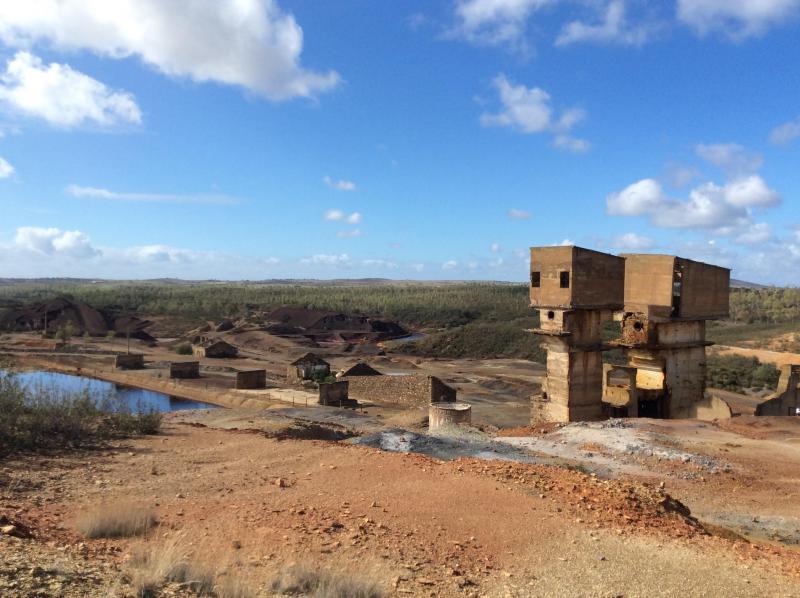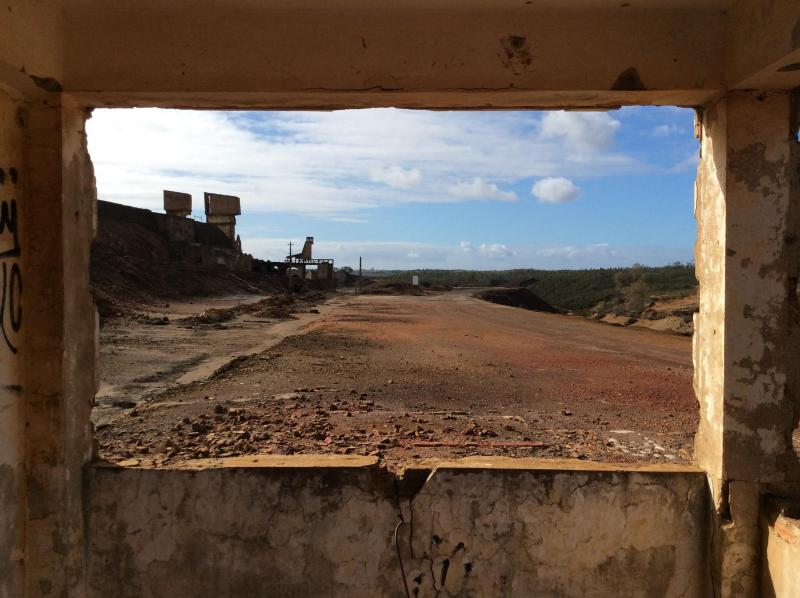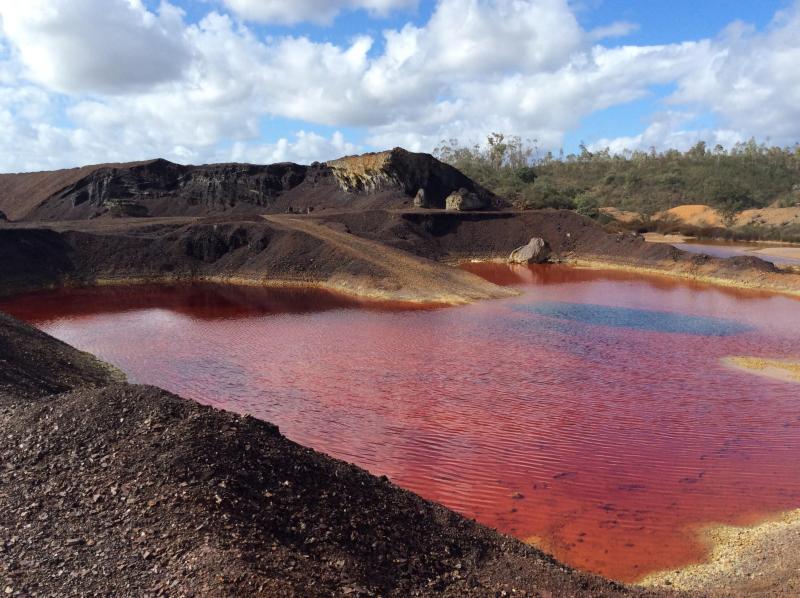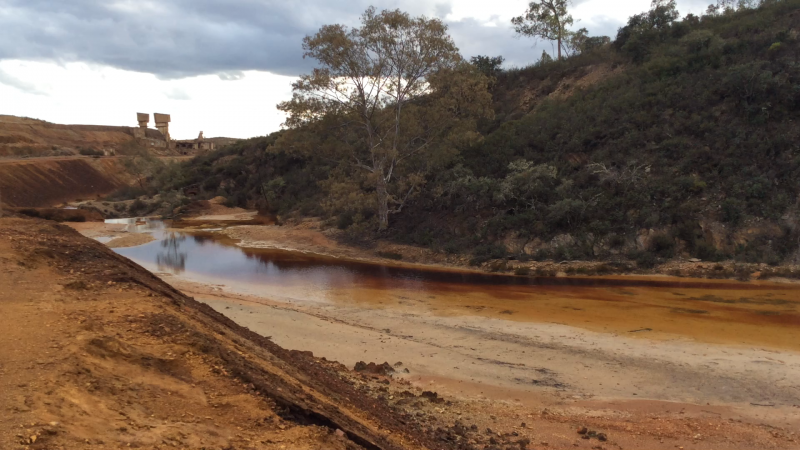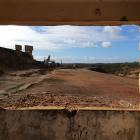In southeast Portugal, set apart from the iconic tourist economies of the Algarve or the entrepreneurial bustle of Lisbon, sits a half-forgotten mining landscape, the modern ruins of the São Domingos Mine. A desiccated industrial landscape begins at a massive open pit, filled with blood-red acid water, left unremediated when the mine closed in the 1960s. Industrial remains sit adjacent to the pit, a patchwork of iron and rubble: old workstations, rusting railway tracks, storage terminals, and rudimentary ore-processing facilities. The mine’s legacy—its almost lunar landscape, profound environmental damage, leaching tailings ponds, slag heaps, contaminated groundwater, and more industrial ruins—continue for 18 linear kilometers until they reach the Guadiana River at Pomarão, where copper pyrite ore and sulfur were laded for transport to the forges and chemical facilities of Britain and elsewhere. And yet, because of the persistence of both modern capital and resilient post-industrial ecologies, there are still signs of life. Here we can see the historical possibilities that emerge from the convergence of industrial heritage landscapes (or the landscapes left behind) and the process of hydrometallurgy, or the use of aqueous solutions in the processing of ore, developed at the São Domingos Mine in the Iberian Pyrite Belt in the early years of its operation from 1854–1966.
Writing about the legacies of abandoned mines in the Canadian North, Arn Keeling and John Sandlos developed the concept of zombie mines to describe the reanimation capabilities of supposedly dead mining landscapes. These zombie mines are given new life all over the world, where capital can find new uses for mining landscapes and where the environmental effects of mining persist. In southeast Portugal, this rebirth emerges out of the industrial, economic, and ecological afterlives of the São Domingos Mine: the direct effects of the hydrometallurgical process alongside the effects of the subsequent chemical economies developed from the roasting of chalcopyrites to extract sulfur primarily for British explosives and petrochemicals during the Second World War. Effects range from the obvious pollution legacies and socioeconomic struggles that follow mine closure, to the development of state-sanctioned industrial heritage tourism. Other effects are more local, such as the development of beach-based tourism built around the two reservoirs constructed for copper production or the presence of plant varieties that have developed symbiotically within the acidic landscapes left behind by the mine.
Places like the São Domingos Mine speak to the use of abstract notions like “potential” and “possibility” as historiographical concepts and analytical frameworks for environmental historians. In this sense, industrial heritage relies on a new focus on historical potential. The Portuguese state can benefit from historical environmental neglect in the present by developing local potential for tourism, precisely because of the environmental despoliation created by the historical industrial intervention. Interpretive signs guide the visitor through the mining ruins, transforming a scorched-earth landscape into a site of tourist interest. A four-star hotel now occupies the converted mining headquarters (the “supervisor’s palace”), with manicured grounds and a high-powered telescope for astronomy enthusiasts. Multiple studies detail potential use values of the sites, championing a range of potential profit-oriented practices: the preservation of geodiversity, training in the remediation of environmental contaminants, the study of (and potential discovery of new) geological samples, and the unknown potential of local plant life for remediation of global mining landscapes. Other studies trumpet the productive possibilities in the “cultural heritage” of the town: the miners’ cabins, a small archive, a local museum/gallery space, and evidence of Roman and Copper Age mining.
Other possibilities have emerged through the relationship between the environmental changes that resulted from past landscape alterations and a nascent tourist economy built upon the new nature of the area. The former mine site, like the town that bears its name, is flanked by two reservoirs created to produce power and direct water resources needed for the hydrometallurgical process, first introduced in 1877. The regional authority has further developed a tourism economy by constructing beaches on the shoreline of the largest of the reservoirs, complete with imported sand.
As Anna Storm has shown in her discussion of northern-European energy and extractive sites, “post-industrial landscape scars” exemplify the ambiguous social and environmental legacies of mining. At São Domingos it is the presence of an endemic plant species, spontaneously emerging in the local acidic post-industrial conditions, that is of interest to environmental historians hoping to follow arguments like those offered by Storm. Erica andevalensis, a small heather that produces pink bell-shaped flowers, has adapted to the toxic legacies of the site. Erica andevalensis is an emblematic species of the Anthropocene. It exists in only two places, at São Domingos and in the tailings and toxic detritus of the nearby Rio Tinto mine in southwestern Spain,that facilitated the export of sulfur from São Domingos to Franco’s Spain beginning in 1934. The plant has been promoted in a way that may pose a small challenge to the declensionist narrative of much environmental history: because it is so specialized to the specific, acidic environmental conditions of these Iberian landscapes, it may yield important insights into the remediation of toxic post-mining landscapes as ecotoxicologists and others test the biotic potential of ruderal species. Moreover, this compact areal specialization effectively renders the plant “endangered,” producing powerful biodiversity claims. These claims may, in turn, further frustrate attempts to secure funding for remediation. In this sense, the possibility and potential created out of environmental dislocation can yield potent normative and material effects, producing further ambiguity out of the ruins of extractive economies and the social and environmental histories they left behind.
How to cite
Peyton, Jonathan. “Abandonment Issues: Producing Industrial Heritage Landscapes at the São Domingos Mine.” Environment & Society Portal, Arcadia (Autumn 2017), no. 32. Rachel Carson Center for Environment and Society. doi.org/10.5282/rcc/8122 (link is external).
ISSN 2199-3408
Environment & Society Portal, Arcadia
 This work is licensed under a Creative Commons Attribution 4.0 International License.
This work is licensed under a Creative Commons Attribution 4.0 International License.
2017 Jonathan Peyton
This refers only to the text and does not include any image rights.
Please click on an image to view its individual rights status.
- Büscher, B., and V. Davidov. The Ecotourism-Extraction Nexus: Political Economies and Rural Realities of (Un)comfortable Bedfellows. Oxford: Routledge, 2013.
- Keeling, A., and J. Sandlos. “Ghost Towns and Zombie Mines: The Historical Dimensions of Mine Abandonment, Reclamation, and Redevelopment in the Canadian North.” In Ice Blink: Navigating Northern Environmental History, edited by S. Bocking and B. Martin, 377–420. Calgary: University of Calgary Press, 2017.
- Mendes, I., et al. “Methodological Issues for Estimating the Total Value of the Rehabilitation of Mining Fields,” International Journal of the Latest Trends in Finance and Economic Sciences 3, no. 4 (2013): 593–610.
- Silva, M. J. R. P. “Narrating Personal and Collective History in Heritage Tourism: Conflicting Representations of the São Domingos Mine and Community,” Material Culture Review 71 (2010): 24–38.
- Serrão Martins Foundation. “Heritage and Potentialities of the São Domingos Mine: The Example of Erica Andevalensis Cabezudo y Rivera.” Exhibit Pamphlet, 2006.
- Storm, Anna. Post-Industrial Landscape Scars. Basingstoke: Palgrave MacMillan, 2014.


